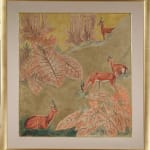

GASTON SUISSE
Reliefs treated with green gold, background in yellow gold
Signed and dated 1930 at the bottom center.
With flat-profile gold leaf frame
61 x 57 1/8 in.
Provenance
This pastel was used as the preparatory work for the lacquer panel that decorated the pavilion of French West Africa during the International Colonial Exhibition in Paris in 1931.
The lacquer panel depicting these antelopes was awarded the gold medal at the exhibition.
Expositions
The 1931 International Colonial Exhibition was held in Paris from May 6 to November 15, 1931, under the direction of Marshal Lyautey. It had a significant impact and welcomed millions of visitors. The exhibition aimed to promote an image of France at the height of its power, presenting itself as a grand popular spectacle.
The exhibition spanned over 1,200 meters in length and included more than 10 kilometers of marked pathways. This vast colonial theme park showcased what had been brought back to France during the colonization of Black Africa, North Africa, Indochina, Syria, and Lebanon.
One of the highlights of the exhibition was the reconstruction of the Angkor Wat temple, alongside the French West Africa pavilion, which featured a building resembling the citadel of Djenné, standing over 40 meters tall. Gaston Suisse contributed to the decoration of both of these pavilions.


